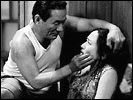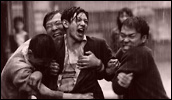Blood and Bones
- Year
- 2004
- Original title
- Chi to Hone
- Japanese title
- 血と骨
- Director
- Cast
- Running time
- 144 minutes
- Published
- 25 July 2005



by Tom Mes
Yoichi Sai's latest exploration of the plight of Japan's Korean immigrant community, Blood and Bones was one of the most lauded films of 2004 on its home turf, riding high on most critics' top ten lists and racking up nominations at the Japan Academy Awards. Not the slightest factor in this success was the overwhelming central performance by Beat Takeshi as the short-fused, anti-social brute Shunpei Kim, a real-life figure who arrived in Osaka by boat from Korea in 1923 as a teenager. Based on the novel by Kim's son Sogiru Yang, Blood and Bones portrays his reign of terror over one of the city's many immigrant communities, extending from his reappearance in the area after a mysterious absence during World War II, up to his sudden return to what is then North Korea in the early 1980s, as a grey-haired old codger.
The words "sprawling" and "epic" quickly come to mind when a film that runs 144 minutes and covers six decades is under discussion, but the irony here is that Sai greatly restricts the scope of his film. Throughout, the camera is kept within the same perimeter, like a dog chained to its house. The same handful of street vistas occur and reoccur many times over, resulting in an almost claustrophobic rather than sprawling film.
Combined with the obvious backlot nature of the sets and the repetitiveness of the script - which follows a simple template: 'Decade X: Kitano beats people up. Decade Y: Kitano is still beating people up' - Blood and Bones can come across as rather wearing on the viewer. Thankfully, Sai's film has more going for it than mere repetition. The director was obviously given the means to do just about anything he wanted (thanks largely to his previous film, the syrupy cute puppy movie Quill, a commercial goldmine), and if he chose to keep the film so cloistered he must have had a reason.
Because what comes across even more strongly than repetition is the sense of isolation. The decades pass, but in the Korean immigrant community things remain resolutely the same. Progress is glimpsed by way of a shiny car or an aeroplane passing overhead, but it remains distant, as if the economic miracle turned a blind eye to this little area of Osaka. If a violent, dictatorial brute like Kim could keep pummelling his neighbours into submission for decades on end, Sai seems to say, it is because the rest of society left these people to rot in their ghetto and was unwilling to share its riches with these outcasts. Democracy, civil rights and the bubble economy never made it to these streets, where the same wooden houses from the start of the century still form the living quarters of most inhabitants by the time the 1980s roll around.
With this portrait of people that history forgot, Sai proves himself the heir to that other great champion of the downtrodden, Kinji Fukasaku. His three generations of Korean immigrants are close cousins to the slum dwellers, the prostitutes and the restless gangsters in Fukasaku's films: all are forced to scrounge in order to get by, ignored by progress, post-war reconstruction and the official account of history. Sai's style may be poles apart from the hyperactive handheld so typical of his predecessor's films, spiritually they are close as kin. Sai even goes one better, additionally suggesting that underneath the rough-edged earthiness and the love of a good brawl so commonly regarded as the spirit of Osaka, extolled everywhere from movies to manga to manzai, rests a dark and deeply troubled past.